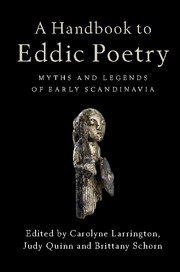Book contents
- Frontmatter
- Contents
- List of illustrations
- List of contributors
- Translations and abbreviations of the titles of eddic poems
- Introduction
- 1 The transmission and preservation of eddic poetry
- 2 Traditions of eddic scholarship
- 3 The editing of eddic poetry
- 4 The dating of eddic poetry
- 5 Eddic performance and eddic audiences
- 6 Eddic poetry and mythology
- 7 Eddic poetry and the religion of pre-Christian Scandinavia
- 8 Eddic poetry and heroic legend
- 9 Place names in eddic poetry
- 10 Eddic poetry and the imagery of stone monuments
- 11 Eddic poetry and archaeology
- 12 Eddic modes and genres
- 13 Eddic metres
- 14 Eddic style
- 15 Kennings and other forms of figurative language in eddic poetry
- 16 Alliterative lexical collocations in eddic poetry
- 17 The representation of gender in eddic poetry
- 18 The reception of eddic poetry
- Consolidated bibliography
- Index
6 - Eddic poetry and mythology
Published online by Cambridge University Press: 05 August 2016
- Frontmatter
- Contents
- List of illustrations
- List of contributors
- Translations and abbreviations of the titles of eddic poems
- Introduction
- 1 The transmission and preservation of eddic poetry
- 2 Traditions of eddic scholarship
- 3 The editing of eddic poetry
- 4 The dating of eddic poetry
- 5 Eddic performance and eddic audiences
- 6 Eddic poetry and mythology
- 7 Eddic poetry and the religion of pre-Christian Scandinavia
- 8 Eddic poetry and heroic legend
- 9 Place names in eddic poetry
- 10 Eddic poetry and the imagery of stone monuments
- 11 Eddic poetry and archaeology
- 12 Eddic modes and genres
- 13 Eddic metres
- 14 Eddic style
- 15 Kennings and other forms of figurative language in eddic poetry
- 16 Alliterative lexical collocations in eddic poetry
- 17 The representation of gender in eddic poetry
- 18 The reception of eddic poetry
- Consolidated bibliography
- Index
Summary
Introduction
When the Germanic peoples – the ancestors of the English, Germans, and Scandinavians – met the Romans during the first centuries CE, they translated the Roman weekday names bearing the names of Roman deities. Thus, we know that Týr (Tuesday), Óðinn (Wednesday), Þórr (Thursday), and Frigg (Friday), to use the names in their Old Norse forms, must have been worshipped or at least known in pre-Christian times across the Germanic speech area, and many other sources support this conclusion. Also, in the Interpretatio romana (ch. 43) of the Roman historian Tacitus’ Germania (Benario 1999), we can easily recognise traits of Óðinn, Þórr, and Týr in descriptions of Mercury, Hercules, and Mars among the Germani, and in doing so we postulate the existence of narratives (myths) about these deities. Such narratives were almost certainly in verse. Since we can reconstruct the existence of alliterative poetry in early Germanic times on the basis of the verse that has survived in Old English, Old High German, Old Saxon, and Old Norse (and on runic inscriptions, many of which technically precede what we call Old Norse), we may infer that mythological alliterative poetry existed among the ancestors of the Anglo-Saxons, Germans, and Scandinavians. For the most part, however, such poetry has survived only in Old Norse. The exception is some charm poetry in Old English and Old High German, where names of mythological beings seem to figure. These include the Old English Charm Against a Sudden Stitch (Elves) and Charm Against Unfruitful Land (Erce, mother of earth) and, especially, the Old English Nine Herbs Charm, which shows Woden (~ Óðinn) in a healing role.
Wyrm com snican, toslat he man;
ða genam Woden VIIII wuldortanas,
sloh ða þa næddran, þæt heo on VIIII tofleah.
þær geændade æppel and attor,
þæt heo næfre ne wolde on hus bugan.
- Type
- Chapter
- Information
- A Handbook to Eddic PoetryMyths and Legends of Early Scandinavia, pp. 114 - 131Publisher: Cambridge University PressPrint publication year: 2016
- 3
- Cited by

